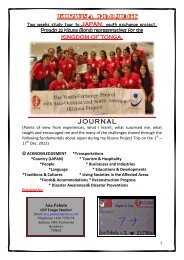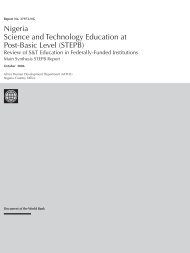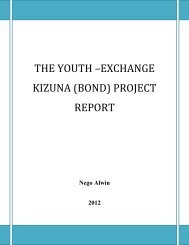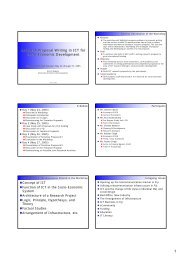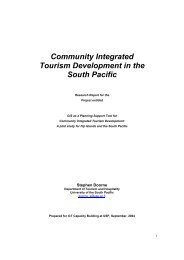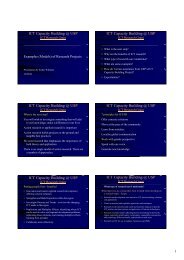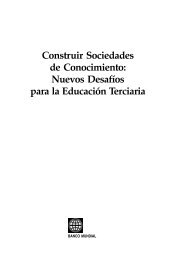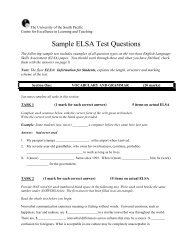- Page 1: 40525 EnhancING China’s Competiti
- Page 4 and 5: © 2007 The International Bank for
- Page 6 and 7: iv Contents 5. Providing the Lubric
- Page 10 and 11: viii Contents 2.4. Scale and propor
- Page 13: Foreword Education and training are
- Page 16 and 17: xiv Acknowledgments on Lifelong Lea
- Page 18 and 19: xvi Preface Although the overall la
- Page 21: Currency Equivalents Currency Unit:
- Page 24 and 25: xxii Abbreviations R&D RTVU SAC SHI
- Page 26 and 27: 2 Enhancing China’s Competitivene
- Page 28 and 29: 4 Enhancing China’s Competitivene
- Page 30 and 31: 6 Enhancing China’s Competitivene
- Page 32 and 33: 8 Enhancing China’s Competitivene
- Page 34 and 35: 10 Enhancing China’s Competitiven
- Page 36 and 37: 12 Enhancing China’s Competitiven
- Page 38 and 39: 14 Enhancing China’s Competitiven
- Page 40 and 41: 16 Enhancing China’s Competitiven
- Page 42 and 43: 18 Enhancing China’s Competitiven
- Page 44 and 45: 20 Enhancing China’s Competitiven
- Page 46 and 47: 22 Enhancing China’s Competitiven
- Page 48 and 49: Table 2.1. (continued) Role of gove
- Page 50 and 51: Table 2.2. Current role of governme
- Page 52 and 53: 28 Enhancing China’s Competitiven
- Page 54 and 55: 30 Enhancing China’s Competitiven
- Page 56 and 57: 32 Enhancing China’s Competitiven
- Page 58 and 59:
Table 2.8. Key areas in a system of
- Page 60 and 61:
Table 3.1. Objectives and assessmen
- Page 62 and 63:
38 Enhancing China’s Competitiven
- Page 64 and 65:
40 Enhancing China’s Competitiven
- Page 66 and 67:
42 Enhancing China’s Competitiven
- Page 68 and 69:
44 Enhancing China’s Competitiven
- Page 70 and 71:
46 Enhancing China’s Competitiven
- Page 72 and 73:
48 Enhancing China’s Competitiven
- Page 74 and 75:
50 Enhancing China’s Competitiven
- Page 76 and 77:
52 Enhancing China’s Competitiven
- Page 78 and 79:
54 Enhancing China’s Competitiven
- Page 81 and 82:
4 Setting the Rules of the Game and
- Page 83 and 84:
Setting the Rules of the Game and D
- Page 85 and 86:
Setting the Rules of the Game and D
- Page 87 and 88:
Setting the Rules of the Game and D
- Page 89 and 90:
Setting the Rules of the Game and D
- Page 91 and 92:
Setting the Rules of the Game and D
- Page 93 and 94:
Setting the Rules of the Game and D
- Page 95 and 96:
Setting the Rules of the Game and D
- Page 97 and 98:
Setting the Rules of the Game and D
- Page 99 and 100:
Setting the Rules of the Game and D
- Page 101 and 102:
Setting the Rules of the Game and D
- Page 103 and 104:
5 Providing the Lubricant for the S
- Page 105 and 106:
Providing the Lubricant for the Sys
- Page 107 and 108:
Providing the Lubricant for the Sys
- Page 109 and 110:
Providing the Lubricant for the Sys
- Page 111 and 112:
Providing the Lubricant for the Sys
- Page 113 and 114:
Providing the Lubricant for the Sys
- Page 115 and 116:
Providing the Lubricant for the Sys
- Page 117:
Providing the Lubricant for the Sys
- Page 120 and 121:
96 Enhancing China’s Competitiven
- Page 122 and 123:
98 Enhancing China’s Competitiven
- Page 124 and 125:
100 Enhancing China’s Competitive
- Page 126 and 127:
102 Enhancing China’s Competitive
- Page 128 and 129:
104 Enhancing China’s Competitive
- Page 130 and 131:
106 Enhancing China’s Competitive
- Page 132 and 133:
108 Enhancing China’s Competitive
- Page 134 and 135:
110 Enhancing China’s Competitive
- Page 136 and 137:
112 Enhancing China’s Competitive
- Page 138 and 139:
114 Enhancing China’s Competitive
- Page 140 and 141:
116 Enhancing China’s Competitive
- Page 142 and 143:
118 Enhancing China’s Competitive
- Page 144 and 145:
120 Enhancing China’s Competitive
- Page 146 and 147:
122 Enhancing China’s Competitive
- Page 148 and 149:
124 Enhancing China’s Competitive
- Page 150 and 151:
126 Enhancing China’s Competitive
- Page 152 and 153:
128 Enhancing China’s Competitive
- Page 154 and 155:
130 Enhancing China’s Competitive
- Page 156 and 157:
132 Enhancing China’s Competitive
- Page 159 and 160:
8 Making China’s Lifelong Learnin
- Page 161 and 162:
Making China’s Lifelong Learning
- Page 163 and 164:
Making China’s Lifelong Learning
- Page 165 and 166:
Making China’s Lifelong Learning
- Page 167 and 168:
Making China’s Lifelong Learning
- Page 169:
Making China’s Lifelong Learning
- Page 172 and 173:
148 Enhancing China’s Competitive
- Page 174 and 175:
150 Enhancing China’s Competitive
- Page 176 and 177:
152 Enhancing China’s Competitive
- Page 179:
Annex 1 China’s Changing Populati
- Page 182 and 183:
158 Enhancing China’s Competitive
- Page 184 and 185:
160 Enhancing China’s Competitive
- Page 186 and 187:
162 Enhancing China’s Competitive
- Page 188 and 189:
164 Enhancing China’s Competitive
- Page 190 and 191:
166 Enhancing China’s Competitive
- Page 192 and 193:
Annex table 5.1. Initial training f
- Page 194 and 195:
170 Enhancing China’s Competitive
- Page 196 and 197:
172 Enhancing China’s Competitive
- Page 198 and 199:
Annex table 6.1. Learning outcomes
- Page 200 and 201:
Annex table 6.1. (continued) Level
- Page 202 and 203:
178 Enhancing China’s Competitive
- Page 205 and 206:
Annex 7 The Bologna Process: Creati
- Page 207 and 208:
The Bologna Process: Creating a “
- Page 209:
The Bologna Process: Creating a “
- Page 212 and 213:
Instrument Description Main Variabl
- Page 215:
Annex 9 Competitive Grant Funding C
- Page 218 and 219:
194 Enhancing China’s Competitive
- Page 220 and 221:
196 Enhancing China’s Competitive
- Page 223 and 224:
Annex 12 Cisco Learning Institute:
- Page 225 and 226:
Annex 13 Tecnológico de Monterrey
- Page 227 and 228:
Tecnológico de Monterrey Virtual U
- Page 229 and 230:
Annex 14 CIBT School of Business an
- Page 231 and 232:
CIBT School of Business and Technol
- Page 233 and 234:
Annex 15 Shanghai Aerospace Compute
- Page 235:
Shanghai Aerospace Computer Enginee
- Page 238 and 239:
214 Enhancing China’s Competitive
- Page 240 and 241:
216 Enhancing China’s Competitive
- Page 243 and 244:
Annex 17 The Challenge of Massive I
- Page 245 and 246:
The Challenge of Massive Industrial
- Page 247 and 248:
The Challenge of Massive Industrial
- Page 249 and 250:
The Challenge of Massive Industrial
- Page 251 and 252:
The Challenge of Massive Industrial
- Page 253 and 254:
References and Other Sources Adey,
- Page 255 and 256:
References and Other Sources 231 De
- Page 257 and 258:
References and Other Sources 233 Hu
- Page 259 and 260:
References and Other Sources 235
- Page 261 and 262:
References and Other Sources 237 Wa
- Page 264:
Following on the World Bank’s 200



